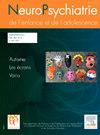Psychomotricite prematurite环境情感(GAPPEA):一种临床研究方法
Q4 Medicine
Neuropsychiatrie de l''Enfance et de l''Adolescence
Pub Date : 2025-09-01
DOI:10.1016/j.neurenf.2025.03.011
引用次数: 0
摘要
本文介绍了GAPPEA网格(格栅替代性心理活动环境情感栅格-替代性心理活动环境情感栅格)的起源、功能和内容。GAPPEA网格是基于camsp在处理早产儿及其家庭的临床实践中遇到的需求而设计的。它回应了需要开发一种新的和原始的工具,用于精神测量学家指导和完善他们在这一领域的临床观察。患者和方法网格在8个月大的婴儿中进行了初步研究,但它也涉及到数十名精神病学家在其使用方面的联系。它以定量和定性方法为基础。结果构建的网格作为观察特定元素的指南,探索不同的精神运动领域,并分为五个观察领域(首次观察、婴儿的精神运动发现、亲子互动和联系、婴儿对精神医生要求的反应、临床医生与家庭之间的联系),每个领域都有具体的详细项目。它把与父母有关的问题放在最重要的位置。讨论就其实验用途而言,网格是与现有支持相关的原创,并且适应了在该临床领域工作的心理测量学家的需要。从使用过它的专业人士那里得到的积极反馈证明了它的有用性。结论GAPPEA的起源和初步应用提示其在婴儿临床方法领域有新的应用前景。以新的方式对其进行测试也将使其能够在以后进行改造甚至校准。本文章由计算机程序翻译,如有差异,请以英文原文为准。
Aux origines de la Grille Alternative Psychomotricité Prématurité Environnement Affectivité (GAPPEA) : une démarche de recherche clinique
Objectives
The article presents the genesis, functioning and content of the GAPPEA grid (Grille Alternative Psychomotricité Environnement Affectivité – Alternative Psychomotricity Environment Affectivity Grid), which was devised based on needs encountered in clinical practice in CAMSPs when dealing with premature babies and their families. It responds to the need to develop a new and original tool used by psychomotricians to guide and refine their clinical observations in this field.
Patients and methods
The grid takes up and puts to work preliminary studies on cohorts of 8-month-old babies, but it also involves the networking of several dozen psychomotricians around its use. It is based on a quantitative and qualitative approach.
Results
The grid was constructed as a guide for observing specific elements exploring different areas in terms of psychomotricity and is divided into five areas of observation (first observations, the baby's psychomotor discoveries, parent/child interaction and links, the baby's response to the psychomotrician's requests, links between the clinician and the family) with specific items presented in detail for each area. It gives pride of place to issues relating to parents.
Discussion
In terms of its experimental use, the grid is original in relation to existing supports and is adapted to the needs of psychomotricians working in this clinical field. The positive feedback received from professionals who have used it testifies to its usefulness.
Conclusions
The genesis and initial uses of GAPPEA suggest that it should be used in new ways in the field of clinical approaches to babies. Putting it to the test in new ways will also allow it to be transformed and even calibrated later.
求助全文
通过发布文献求助,成功后即可免费获取论文全文。
去求助
来源期刊

Neuropsychiatrie de l''Enfance et de l''Adolescence
Medicine-Pediatrics, Perinatology and Child Health
CiteScore
0.60
自引率
0.00%
发文量
61
期刊介绍:
Organ of the Société française de psychiatrie de enfant et de adolescent, Neuropsychiatrie de enfance et de adolescence tackles all fields of child-adolescent psychiatry and offers a link between field and clinical work. As a reference and training tool for students and practitioners, the journal publishes original papers in child psychiatry as well as book reviews and conference reports. Each issue also offers a calendar of the main events dealing with the speciality.
 求助内容:
求助内容: 应助结果提醒方式:
应助结果提醒方式:


